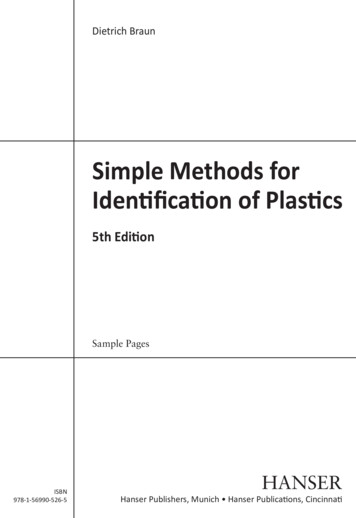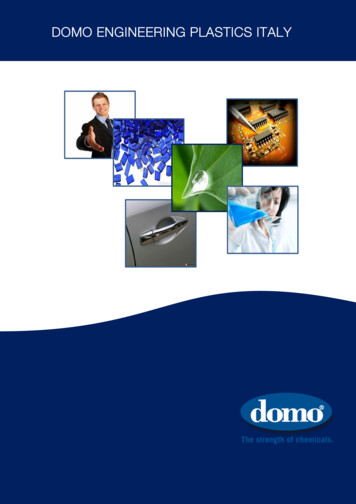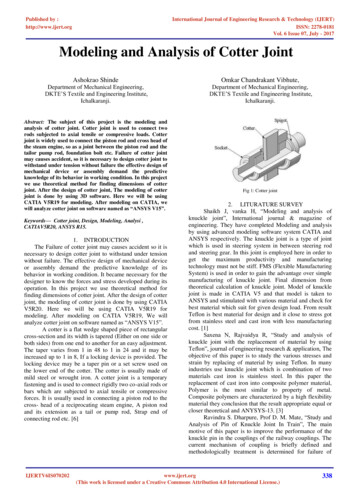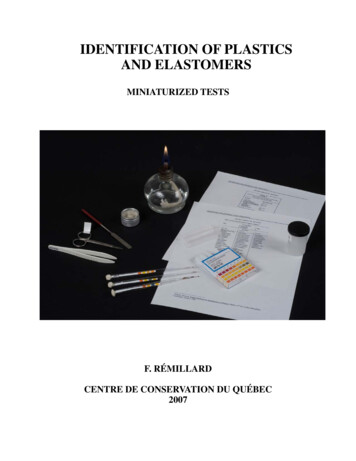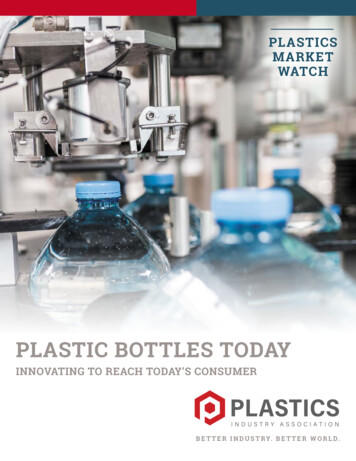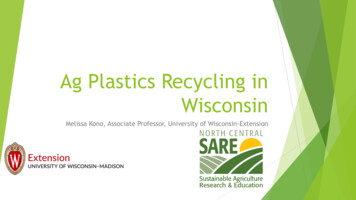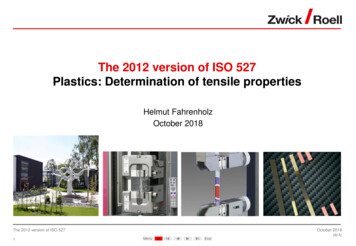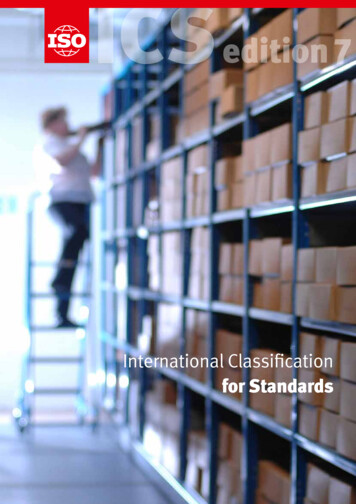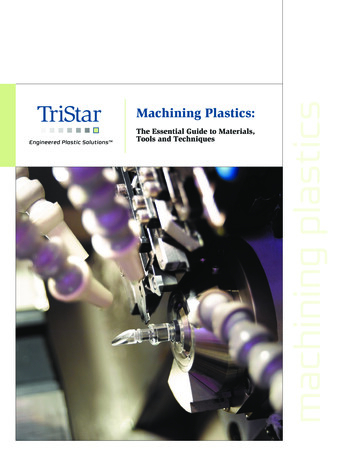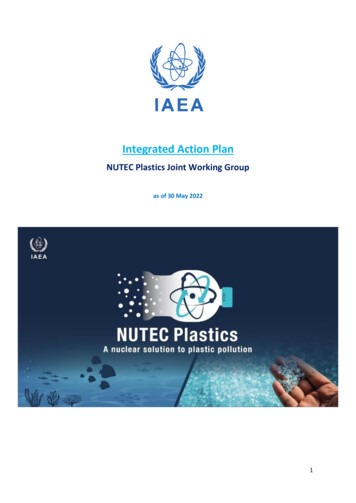
Transcription
Integrated Action PlanNUTEC Plastics Joint Working Groupas of 30 May 20221
ContentsAcronyms .3Background .4The IAEA NUTEC Plastics Implementation Plan .4Annexes (As of 30 May 2022) . . .12Annex 1 13Annex 2 14Annex 3 15Annex 3a .16Annex 4 19Annex 5 20Annex 6 XX2
AcronymsNameAcronymInternational Atomic Energy AgencyIAEAUnited NationsUNNUclear TEChnology for Controlling Plastic PollutionNUTECPlasticsJoint Working GroupJWGIAEA Technical Cooperation ProgrammeTCPIAEA Department of Technical Cooperation Division for Asia and the PacificTCAPIAEA Department of Technical Cooperation Division for EuropeTCEUIAEA Department of Technical Cooperation Division for AfricaTCAFIAEA Technical Cooperation Division for Latin America and the CaribbeanTCLACIAEA Department of Nuclear Science and ApplicationsNAIAEA NA Division of IAEA Marine Environment LaboratoriesNAMLIAEA NA Division of Physical and Chemical SciencesNAPCExtra Budgetary ResourcesEBPeaceful Uses InitiativePUIUN Environment ProgrammeUNEPGroup of TwentyG20UN Economic and Social Commission for Asia and the PacificUNESCAPUN Industrial Development OrganizationUNIDOUNEP Mediterranean Action PlanUNEP/MAPProgramme for the Assessment and Control of Marine Pollution in theMediterraneanMED POLIntergovernmental Oceanographic Commission of UNESCOIOC-UNESCOGlobal Plastic Action PartnershipGPAPJoint Group of Experts on the Scientific Aspects of Marine EnvironmentalProtectionGESAMPAssociation of Southeast Asian NationsASEANEnvironmental Management GroupEMG3
BackgroundIn 2020, the IAEA launched, NUclear TEChnology for Controlling Plastic Pollution (NUTECPlastics), aimed to highlight the unique contributions of nuclear technology to the global,regional, and national actions for the solution of plastic pollution. The IAEA partners withvarious stakeholders to develop and mainstream these new solutions, using its existingdelivery mechanisms for both research and development and building capacity in its MemberStates to tackle this global problem. NUTEC Plastics focus is two-pronged: a) to enhance globalunderstanding of the abundance and impact of marine plastic pollution; and b) to enhanceplastic recycling to complement conventional practices and production of sustainablealternatives to petroleum-based plastics through the application of radiation techniques.NUTEC Plastics projects, as peaceful uses initiatives (PUI), coordinated research projects(CRP), and national and regional technical cooperation (TC) projects, and dedicated activitiesaddress nuclear solutions to global plastics pollution challenges. A Joint Working Group (JWG)with members from the Departments of Nuclear Sciences and Applications and TechnicalCooperation was formed to coordinate delivery of NUTEC Plastics projects and activitiesharmonize collaboration and optimize impact. This document describes the JWG’s IntegratedAction Plan for NUTEC Plastics delivery.The JWG’s Integrated Action Plan for NUTEC Plastics has three major areas of action: Action1: Implementation of activities for the assessment, planning and establishment of a pilotplant(s) for plastic waste recycling, Action 2: Marine microplastic monitoring and assessment,and Action 3: NUTEC Plastics Outreach and Partnership Building. Details of the upstreamACTION 1 part of NUTEC Plastics are detailed in the link to ANNEX 1 found on page 12 of thisdocument and a summary of its status in May 2022 on page 13. Details of the downstreampart (ACTION 2), monitoring and impact assessment of microplastics, are summarised inANNEX 2 (link page 12 and summary of May 2022 status on page 14). A framework as well asa list of activities focused on dissemination and partnerships is curated by TC and NA andincluded in ANNEX 3/3a. The NUTEC Plastics extra-budgetary resource is briefly outlined inthe ANNEX 4. ANNEX 5 lists TC projects related to NUTEC Plastics.This is intended to be a living document, meaning that the ANNEXES are embedded as links,which open the ANNEX document as its most recent update. These ANNEXES are found in aJWG internal SharePoint site accessible to JWG members, as the working document that iscontinually updated to track progression and impact.The IAEA NUTEC Plastics Implementation PlanThe IAEA NUTEC Plastics initiative supports its Member States in its two-pronged(upstream/downstream) approach, which complements national and regional efforts throughthe following three actions. The upstream component targets reducing global plastic wastevolumes using radiation technologies. This is done in two ways: by producing bio-based singleuse plastic products and by innovating plastic waste recycling. This document only coversactivities related to innovating plastic recycling.4
Action 1: Implementation of activities for the assessment, planningand establishment of a pilot plant(s) for plastic waste recycling.Action 1 supports the development of a pilot plant (or plants) using nuclear technology forinnovating plastic waste recycling in a Member State(s) by 2025.Action 1’s four-staged approach involves Stage 1: capacity building, Stage 2: verification ofproof of concept and economic feasibility, Stage 3: Pilot plant build and operation ofirradiation-assisted plastic recycling plant(s), and Stage 4: ultimate upscaling tocommercialisation in partnership.Upstream activities in application of radiation technologies to innovate plastic recycling:stages, timelines, and targeted outcomesTo achieve this, activities are planned with the following main outputs:Stage 1.̶ A pipeline of skilled work force prepared for regional cooperation- Member States’ proposals for pilot plastic recycling plants developed in theform of draft feasibility studies- Guidelines/Guidance document for setting up inline irradiation facilities at apolymer recycling siteStage 2. ̶ Validated technology and financial feasibility for implementation of a pilotplant(s)5
Stage 3.Stage 4.̶ Pilot plant design for case studies proposed by Member States, build andoperation̶ Technological readiness of radiation assisted plastic recycling at a level 7 orhigher for case studies developed and ready for handover for upscaling to ademonstration plant and ultimate commercialisationNote that this strategic, staged approach is intended as a rolling plan, that is periodicallyupdated with results. Those updated results, in turn, allow and guide increasing thegranularity of the planning of subsequent stages. The status of the stages in Action 1 are foundin the link to ANNEX 1.Projects currently under implementation (May 2022) towards the objectives of Action 1 areas follows: TCAP: One national project (INS1031) ‘Using Radiation to Mitigate Plastic Waste –Nuclear Technology for Reducing Plastic Pollution’ supports institutions in Indonesiato reduce the amount of plastic waste through an integrated recycling system; andone regional project (RAS1024) ‘Reutilizing and Recycling Polymeric Waste throughRadiation Modification for the Production of Industrial Goods’ provides support toBangladesh, China, Indonesia, Malaysia, Myanmar, Philippines, Thailand, Viet Namand Sri Lanka, Indonesia, Malaysia, Philippines, and Thailand to strengthen regionalcapabilities in the application of radiation technology for industrial, health-care andenvironmental applications.TCAF: One national project in Ghana (GHA1015) ‘Using Nuclear Technology forManaging Plastic Waste’ which promotes radioisotopes and radiation technology forindustrial, health-care and environmental applications, and one regional project(RAF1010) ‘Reutilizing and Recycling Polymeric Waste Through Radiation Modificationfor the Production of Industrial Goods’ supports the acceleration in the transitiontowards a circular plastic economy by adopting and applying nuclear science andtechnology solutions to Kenya, Morocco, and South Africa.TCLAC: Part of a national project in Argentina (ARG1029) ‘Implementation of RadiationTechnology Using Electron Beam for Industry and Environmental Applications’ whichaims to mitigate environmental contamination produced by industrial and domesticliquids effluents and generate value-added products in various sectors, and a newregional project (RLA1020) ‘Promoting Radiation Technology in Natural and SyntheticPolymers for the Development of New Products, with Emphasis on Waste Recovery,supporting Argentina, Brazil, Bolivia, Chile, Colombia, Costa Rica, Cuba, Mexico,Panama, Uruguay, and Venezuela to contribute to the reduction of the environmentalimpact of natural and synthetic polymer wastes using irradiation techniques. TCEU:one ongoing regional project (RER1021) ‘Enhancing the Use of Radiation Technologiesin Industry and Environment’ has included NUTEC Plastics Stage 1 and 2 activitiescontributing to improving human health, keeping a cleaner environment, anddeveloping advanced materials through the extended and qualified use of radiationtechnologies starting in 2021 for institutions in Croatia, Hungary, Romania, Poland,and Turkey. For these 5 Member States and others, thru TCEU project RER1021, TC6
has provided support for awareness raising, capacity building in general andspecifically for the feasibility report preparation (in the form of 1 regional trainingcourse held together with TCAP over 4 months). No TC funds for hardware/equipmenthave been provided.NAPC: “Recycling of Polymer Waste for Structural and Non-Structural Materials byusing Ionizing Radiation” (a NUTEC Plastics CRP F23036) with the overall objective toperform coordinated, applied research and development to demonstrate feasibilityand optimised scale-up of plastic waste recycling using radiation technologies in thefollowing countries: Algeria, Argentina, Brazil, China, Croatia, Egypt, Ghana, Hungary,Indonesia, Malaysia, Peru, Philippines, Poland, Russian Federation, Serbia, Thailand,Turkey, VietnamFig 1. NUTEC recycling by irradiation R&D and technology transfer activities*Status as of May 2022Action 2: Marine microplastic monitoring and assessment.Action 2 supports the establishment, by 2026, of a Global NUTEC Plastics Monitoring Networkof 50 specialized laboratories worldwide (NUTEC Marine Plastic Monitoring Laboratories),located in Member States capable of assessing the risks that marine microplastics pose totheir ecosystems and livelihoods, supporting the development of global policies and actionsfor the sustainability of the seas and oceans in all 4 regions.The IAEA Marine Environment Laboratories in Monaco will serve as a global referencelaboratory and scientific-technical support in marine plastic pollution monitoring for theNUTEC Marine Plastic Monitoring Laboratories. IAEA Marine Environmental Laboratories inMonaco will enhance capabilities, instrumentation and expertise in the characterization andquantification of marine microplastics.7
Action 2’s four-staged approach involves 1: Capacity building, Stage 2: Strengthening IAEALaboratory, Stage 3: Filling knowledge Gaps, and Stage 4: Global NetworkTo achieve this, activities are planned with the following main outputsStage 1:Guidelines/guidance documents for monitoring microplastics using nuclear andisotopic techniques.Member States implement marine plastics monitoring programs according toharmonized and validated protocols for reporting on SDG 14 (NUTEC MarinePlastics Monitoring Laboratories with equipment, appropriate protocols andtrained staff established)Stage 2:International Reference Laboratory is established at NAML to support MemberStates in marine plastics monitoring and research.Stage 3:Member States have information and knowledge on sources, distribution,trends, transport, bioaccumulation and their impacts on biodiversity and foodto ensure sustainable development.Stage 4:Global network of marine laboratories for monitoring and assessing the impactof marine plastic pollution.To implement Action 2, a results-based approach with continuous adjustments andimprovements have been followed. The harmonization and phased implementation allow tointegrate the activities into national, regional and interregional project cycles. The currentand updated status of the Action 2 phases can be found in ANNEX 2.Projects currently under implementation (May 2022) towards the objectives of Action 2 areas follows:8
TCAP: 1 Regional NUTEC TC Project (RAS7038) supporting 19 countries: Bangladesh,China, Indonesia, Iran, Iraq, Israel, Jordan, Japan, Kuwait, Malaysia, Pakistan,Palestine, Philippines, Qatar, Saudi Arabia, Sri Lanka, Syria, Thailand, and Viet Nam.RAS7038 project is aimed at building capacity for microplastics monitoring in theregion to support the development of policies, regulations, standards as well asSDG14.TCAF: a national project in Ghana (GHA1015), and a regional (RAF1010) projectproviding support also to Kenya, Morocco, and South Africa. NUTEC TC regionalprojects for capacity building in microplastics monitoring are needed in this region.TCLAC: 7 national NUTEC Project (BRA7012, BRA7014, CUB7010, BZE7004, TRI7002,CHI7014 and ECU0009) and 2 regional NUTEC Project (RLA7025 and RLA0063), supportlaboratories in 22 countries: Antigua and Barbuda, Argentina, Belize, Brazil, Chile,Colombia, Costa Rica, Cuba, Dominica, Dominican Republic, Ecuador, El Salvador,Guatemala, Honduras, Jamaica, México, Nicaragua, Panamá, Peru, Trinidad andTobago, Uruguay, and Venezuela. These projects are aimed at building capacity formicroplastics monitoring in the region to support the development of policies,regulations, standards as well as SDG14. The REMARCO network coordinates regionalactions and focuses its actions to implement SDG14 with other regional stakeholders(UNEP, Cartagena Convention, and IOC regional programs).TCEU: one regional project (RER7015) provides initial support to 14 countries: Albania,Bosnia and Herzegovina, Bulgaria, Croatia, Cyprus, Georgia, Greece, Montenegro,Romania, Russian Federation, Slovenia, Turkey, Turkmenistan, and Ukraine. NUTEC TCregional projects on microplastics monitoring are needed.NAML: Under RB Project 2000131 “Isotope tools for studying climate andenvironmental change” linked to Marine Environment Program, technologies forsampling and analysis of nano- and microplastics in marine ecosystems are developedand validated. These technologies are being transferred to Member States through TCNUTEC projects. PUI “Marine Plastics” and CRP K41019 "Applied radioecologicaltracers to assess coastal and marine ecosystem health" are conducting preliminaryresearch on the behaviour and impacts of microplastics in the oceans.A new NUTEC CRP with the overall objective of carrying out research and developmentcoordinated and to demonstrate the feasibility of nuclear and isotopic techniques inunderstanding microplastics in the oceans is being designed9
Fig 2. NUTEC marine monitoring R&D and technology transfer activities*Status as of May 2022Action 3: NUTEC Plastics Outreach and Partnership BuildingThe transboundary nature of the plastic litter crisis requires a swift and coordinated multi-stakeholderresponse. As many organisations across the UN System, NGOs, and other relevant actors have initiatedcomprehensive action to solve this issue, it is of the upmost importance for the IAEA to reach out,engage in partnerships, and demonstrate the roles that nuclear technologies have in tackling plasticpollution in recycling and monitoring.This will be achieved through Action 3 NUTEC Plastics Outreach and Partnership Building. Partnershipswith and between governments, international organizations, civil society, academia, the privatesector, and non-governmental organizations will be sought and nurtured to raise global awareness ofthe benefits that IAEA NUTEC Plastics offers in the nuclear-based technologies as part of the solutionto plastic pollution challenges.Additionally, investments are required to enable these innovative sustainable plastic managementpractices and the IAEA will seek partnership with international financial institutions and contributewith the scientific bases for required investments for the circular plastic economy to be effective.This Action 3 directly supports the core components of NUTEC Plastics, Actions 1 and 2. Action 3 hasthe following targets (ANNEX 3): Raising global awareness on the application of isotopic techniques for marine plasticmonitoring and irradiation technologies in plastic irradiation via dedicated campaigns, such aswebinars, Member State briefings, and liaising with decision makers, public, and scientificcommunity in global, regional, or national fora. Technical and Strategic Partnership (public and private) will be established, making use ofsynergies with relevant initiatives at national, regional, and global level, in order to mainstreamthe IAEA NUTEC Plastics initiative.10
Financial Partnership (traditional and non-traditional) will be sought for complementary orsupplementary support to relevant programmes undertaken by the IAEA Secretariat,particularly for strengthening laboratories delivering NUTEC Plastics activities, as well toMember States through the TC programmes, so that their national capabilities to tackle plasticpollution problems using nuclear technologies for monitoring and for recycling are significantlystrengthened.Fig 3. Countries participating in the NUTEC Plastics initiative*Including donors/ *Status as of May 202211
ANNEXES (Descriptor and links to living documents continuously updated)ANNEX 1 Results framework of the implementation of activities for establishing a pilot plant(s)for plastic waste recycling according to the strategic four-staged approachANNEX 2 Results framework of Marine microplastic monitoring and assessment, targetingestablishing an operational Global Network of marine Laboratories for monitoring and impactassessment of marine plastic pollutionANNEX 3 Results Framework of activities on outreach and partnershipsANNEX 3a Status of implemented activities Outreach and Partnership BuildingANNEX 4 NUTEC Plastics Budget and list of extra-budgetary resourcesANNEX 5 TC projects related to NUTEC PlasticsANNEX 6 NUTEC Progress Periodic Report12
ANNEX status capture May 2022ANNEX 1ACTION 1: Implementation of the Activities for Establishing a Pilot Plant(s) and proven technonolgy for plastics waste recycling in 4stages (2021-2025)OBJECTIVE: Improved Recycling and Production Methods Through the Application of Radiation Techniques to ComplementConventional PracticesSTAGE 1Implementation TimelineObjective: Build Capacity in Application of Radiation Technologies for Plastic Waste Recycling to Level of Existing Know-How2021SubstageOUTPUTACTIVITIESS1.1Pipeline of skilled work force and newcomers forregional cooperationCapacity building activities for young researchers and newcomers in radiationtechnologies for plastic waste recyclingModel feasibility study and Member States' casestudies for proposed pilot plastic recycling plantsdevelopedFour month phased workshop, generating draft feasibility studies for a pilotplastic recycling plant(s)20222023Phase 1: Technology identification for target application and existinginfrastructure will define process flowsheetsPhase 2: Irradiation system selection – required layout, power, safety,operation, and maintenance issues frame concept design draftS2.1Phase 3: Microeconomic studies – projecting balance of market demand andproduct revenue to capital investment and operating costsPhase 4: Macroeconomic feasibility, socioeconomic and technological benefits –identification of knowledge and financial gapsS3.1STAGE 2Guidelines/Guidance document for setting upinline irradiation facilities for polymer recyclingdevelopedDevelopment and dissemination of guidelines for setting up inline irradiationfacilities for polymer recyclingObjective: Fill knowledge and financial gaps through verifications studies to enable financial feasibility by supporting policies and/orproduction of higher value products to offset financial gapsS2.1Validated technology and financial feasibility forimplementation of pilot plant/s.Validation tests to address "unknown and knowledge gaps" identified in stage 1of the feasibility study on pilot projects (case studies) proposed by MemberStatesS2.2Economic feasibility of validated technologyDialogue with stakeholders to fill identified financial gaps in both investmentand operation costsS3.2Objective: Translation of results from Stages 1&2: support to Member State(s) to adjust the advanced engineering design of theirtargeted pilot plant(s) and ultimately build and operate a pilot plastic recylcing plantSupport and guidance to Pilot Countries to develop advanced engineeringdesign of targeted pilot plant(s) and its implementation (construction,Pilot plant design proposed by Member Statescommissioning and operation)(pilot countries) developed and implementedTechnology transfer, dissemination, and partnership developmentSTAGE 4Objective: Technology of pilot plant brought to a readiness level 7, so that commercial interest is wakenedS4Capture of the experience gained in construction and operation of the pilotUPSCALING AND DISSEMINATION of technology plant(s) and lessons learned made available to all Member States - advancementTRL 7 or higherof technology to a readiness level for commercialhand-over for demonstrationplant developmentSTAGE 3S3.1*as of May 20221320242025
ANNEX status capture May 2022ANNEX 2ACTION 2: Marine microplastic monitoring and assessment (2021-2025)Objective: Enhanced global understanding of the abundance and impact of marine plastic pollution.OUTCOME: A Global NUTEC Plastics Monitoring Network of specialized laboratories in Member States able to assess risks posed by marine plastics totheir ecosystems and livelihoods, consisting of 50 NUTEC laboratories worldwide located in all 4 regions.STAGE 1SubstageObjective: Harmonize protocols and build capacity in member states formonitoring of marine plastics in the oceanOUTPUTACTIVITIESGuidelines/guidance documents formonitoring microplastics using nuclearand isotopic techniques.S1.1S.1.2S2S2.1S3S3.1S4Member States implement marineplastics monitoring programs accordingto harmonized and validated protocolsfor reporting on SDG 14Implementation Timeline2021202220232024Expert group work for the development,validation, harmonization, anddissemination of protocols for sampling andanalysis of marine plastics (Workshops,training courses, consultants, experts).NAML (RB Project 2000131, PIU and CRP)National and regional TC NUTEC project.Capacity building in NUTEC PlasticsMonitoring Laboratories using a package ofnuclear techniques developed by NAML(sampling kits, laser vibration spectroscopy,mass spectrometry, radiotracers andradiochronology). TC NUTEC Project andNAML.Objective: Establish an International Reference LaboratoryInternational Reference Laboratory isestablished at NAML to supportMember States in marine plasticsmonitoring and research.Develop a High-Level Analytical TechniquesPlatform for plastics studies at NAML.Improve, update and enhance capabilitiesfor the quantification of micro and nanoplastics in the marine environment(acquisition of equipment and support of EBStaff, JPO and Consultants.)Objective: Enhance scientific understanding of the impact of marine plasticInformation and knowledge on sources,distribution, trends, transport,bioaccumulation and their impacts onbiodiversity and food to ensuresustainable development.Development and dissemination of resultsobtained from coordinated research withMember States on sources, distribution,trends, transport, bioaccumulation andtheir impacts on biodiversity and food toensure sustainable development. NAML:new NUTEC CRP, PUI Marine Plastic and TCNUTEC projects.Objective: Build a NUTEC Global NetworkEstablishment of operational NUTECRegional Laboratories. Developcoordination mechanisms for NUTECplastics monitoring laboratories worldwide.S4.1NUTEC Global Network of MarineLaboratories for monitoring andassessing the impact of marine plasticpollution.NUTEC Marine Global Platform withdatabase, knowledge, and best practices formicroplastics monitoring.Global report on status and trends ofplastics pollution in seas and oceans.142025
ANNEX status capture May 2022ANNEX 3aANNEX 3ACTION 3: NUTEC Plastics Outreach and Partnership BuildingImplementation TimelineOUTCOMESGlobal Awareness Raised on the Benefitsof the Application of Nuclear BasedTechniques for Marine Plastic Monitoringand Plastic RecyclingACTIVITIESI. NUTEC awareness raising: Targeted Outreach to a range of stakeholders,including Decision Makers, public, sister UN organisations and the ScientificCommunityRegional roundtables conducted and follow-up actions developedII. Communication and Outreach Material - Publication of four outreachreference documents on NUTEC Plastics in IAEA webI. Representation at global fora and major scientific events in the area of plasticmonitoring and plastic reuse and recycling20212022202320242025TCAP-TCAF TCLAC-TCEU1) NUTEC FLYER2) NUTEC BROCHURENUTEC Portal3) ROUNDTABLESUMMARY (TCAP)- Inclusion of IAEA in G20Report for the first time,follow-up actions for the G20Summit - 7th MultiStakeholder Forum on STI forthe SDGs VIRTUALIAEA GC Side Event on NUTEC PlasticsII. Targeted Outreach to Decision Makers and Scientific CommunityUNESCO - IAEA collaboration in the UNESCO Ocean Data and Information Networkfor AfricaWorkshops with UNEP LAC planned to improve monitoring capacities of marinelaboratoriesIAEA (DG) attend the 2022 UN Ocean ConferenceParticipation in IOC-UNESCO Group of Experts on Scientific Aspects of MarineEnvironmental ProtectionTechnical and Strategic PartnershipsEstablishedUpdating MoU and Letter of Agreements with UNEP/MAP for MediterraneanAction PlanDIRs NAPC and NAML named by the DG as Agency focal points for the newEnvironmental Management Group (EMG) Consultative Process on a PollutionFree PlanetNAML participation in Marine Litters and Microplastics Task Team of the UNEMGled by UNEPRegional WS on Harmonization of Monitoring Strategy and Analysis of MicroPlastics Pollution in the LAC Coastal ZonesLaunch of the Guidelines for radiation assisted polymer recycling for MemberStatesMember State BriefingsIII. Targeted Outreach to Decision Makers in Public and Private Sector - NationalStakeholder Meetings with pilot countries to promote awareness on potentialnuclear applications and contribution of NST to address plastic pollutionI. Identification of partners (public and private) interested in contributing toimprove marine laboratories monitoring capacitiesHigh level meeting to present projects to selected countries and partners.Definition of national programs and commitments, co-financing and in-kindcontributions - Identification of MS interested in improving their marinemonitoring capacities - IAEA proposal for partnership with the Khaled bin SultanLiving Oceans Foundation on NUTEC PlasticsFinancial Parnerships EstablishedII. Identification of partners (public and private) interested in investing inirradiation facilities to complement existing recycling methodsMulti stakeholder’s consultation meetings to jointly identify technological gapsthat could be addressed by radiation technology for closing the loop of the circularplastic economy - Identification of MS interested in improving their plasticsirradiation capacities and applications - Support and coordination of UNIDO Ghanaplastics project in support to GH-NPAP and partially funded through the GEFprogrammePublic/private partnerships for validation and upscaling of the irradiationtechnology in recycling - Follow up from Regional Workshops on the TechnicalEconomic Feasibility Studies to Implement Radiation Technology for the Recyclingof Polymer WasteBilateral presentations and discussion to secure funding*as of May 202215
ANNEX status capture May 2022Annex 3aStatus of activities Outreach and Partnership BuildingThe following have been achieved for the time period May 2021- March 2022:I. Global Awareness: Four regional roundtables engaging Member States, industry, international organizations,academia, and civil society in a dialogue on how to address global plastic pollution with aparticular focus on the contribution nuclear technologies can make. These roundtabledialogues led to new insights, new partnerships, and the development of follow up actions aswell as increased mobilized extra budgetary (EB) resources, from Japan, South Korea, the USAand Sweden (ANNEX 4). Publication of three outreach reference documents on NUTEC Plastics in IAEA web: 1) FLYER:NUTEC Plastics — A nuclear solution to plastic pollution 2) BROCHURE: NUclear TEChnologyfor Controlling Plastic Pollution; 3) ROUNDTABLE SUMMARY: For Asia and the Pacific RegionII. Technical and Strategic Partnership 62 countries requested assistance from IAEA through the TC programme for support in solvingthe plastic pollution problem under NUTEC Plastics; in response, 19 national and regionalprojects across all regions were approved by Board. 8 MS are presently being supported in the initial assessment and planning for the potentialfuture establishment of pilot plant(s) for plastic waste recycling: Argentina, Brazil, Ghana,Indonesia, Malaysia, Mexico, Philippines, and Romania. Inclusion of IAEA in G20 Report for the first time, follow-up actions progressing with thefollow-up actions for the G20 Summit: 2022 in Indonesia – initial discussions with the PrimeMinister of Indonesia. Joined the GPAP and participated in the Regional Coordination WorkingGroups for Southeast and South Asia Region, LA, Africa. The JWG aims to bring regionalexpertise to
plant(s) for plastic waste recycling, Action 2: Marine microplastic monitoring and assessment, and Action 3: NUTEC Plastics Outreach and Partnership Building. Details of the upstream ACTION 1 part of NUTEC Plastics are detailed in the link to ANNEX 1 found on page 12 of this document and a summary of its status in May 2022 on page 13.


